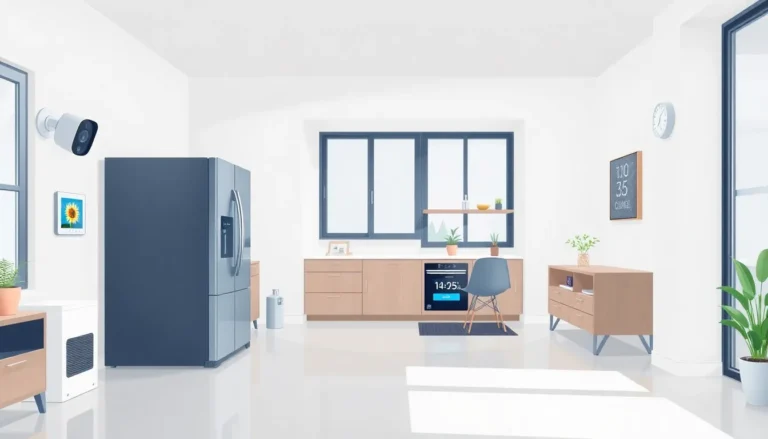Table of Contents
ToggleImagine walking into your living room and seeing a sleek new couch materialize right before your eyes. With augmented reality furniture, that dream’s become a reality. This innovative technology lets you visualize furniture in your own space without lifting a finger—or a heavy sofa. It’s like having a personal interior designer, minus the awkward small talk.
Overview of Augmented Reality Furniture
Augmented reality furniture enhances the way individuals interact with potential home decor. Users benefit from visualizing how various items will appear in their spaces before making a purchase. This technology employs smartphone applications or AR glasses to overlay digital images of furniture on real-world environments.
Visual placement of items in living rooms, bedrooms, or other areas provides invaluable context. Shoppers can see how dimensions align with existing decor, ensuring proper fit and harmony with the current aesthetic. Color schemes and designs come to life, showcasing a clearer picture of the final look.
Several leading companies, such as IKEA and Wayfair, incorporate AR features directly into their retail platforms. Users can view 3D models and rotate them for different angles, adjusting placement on their screens. This level of interactivity transforms the shopping experience, making it more engaging and immersive.
Augmented reality furniture not only aids in decision-making but also reduces return rates. When customers accurately visualize products in their homes, satisfaction increases, minimizing the likelihood of dissatisfaction post-purchase. Technology also caters to various styles, from modern minimalism to classic elegance, addressing diverse consumer preferences.
In addition, augmented reality platforms frequently update their catalogs, providing access to the latest designs and trends. This constant refresh aids users in finding unique pieces that match their tastes, enhancing the overall shopping experience. Moving forward, augmented reality furniture will likely continue evolving, pushing boundaries and setting new standards in interior design.
Benefits of Augmented Reality Furniture

Augmented reality furniture offers numerous advantages that enhance the shopping and designing experience.
Enhanced Visualization
Users can see how different furniture pieces fit in their spaces with augmented reality. Virtual overlays allow for accurate assessments of scale and style. Customers manipulate 3D models, rotating them to view all angles and details. Access to a variety of colors and materials further personalizes choices. By visualizing furniture in context, individuals can make decisions tailored to their home aesthetics. AR technology also eliminates the awkwardness of imagining how a new item would truly fit. Companies like IKEA and Wayfair leverage this advantage, allowing potential buyers to experience how items harmonize with existing decor.
Improved Decision-Making
Improved decision-making stems from augmented reality furniture’s interactive nature. Customers gain confidence when they can ‘test’ items within their environment. Visualizing furniture reduces uncertainty that often leads to returns. With clear representations and comparisons, users identify attributes that suit their preferences. Smart technology also highlights functional benefits, making it easier to choose items compatible with lifestyle needs. Shopping becomes more efficient, encouraging informed purchases without feeling overwhelming. Enhanced experiences lead to increasing satisfaction, reducing buyer’s remorse.
Popular Augmented Reality Furniture Apps
Several apps showcase the power of augmented reality in furniture shopping. Users access various features and benefits through these platforms, enhancing their buying experience.
App 1: Features and User Experience
IKEA Place offers exceptional features for users seeking to visualize furniture in their homes. This app allows individuals to place 3D models in real-time environments using their smartphones and tablets. Engaging visuals help users understand scale and fit. They can select from a vast catalog that includes various designs and styles. Interactive features enhance usability, making it easy to rotate or move furniture within the space. Customers reported high satisfaction rates, leading to more confident purchase decisions. Users appreciate its straightforward interface and seamless integration with IKEA’s product offerings.
App 2: Comparison with Competitors
Wayfair’s app provides robust competition with unique features. Users benefit from a wide range of furniture options alongside detailed product information and pricing. Enhanced filters let individuals search by style, color, or dimensions, making it easy to find the perfect piece. Real-time AR visualization allows users to see how items will look in their rooms. While IKEA Place focuses on an extensive product catalog, Wayfair emphasizes a more personalized shopping experience. Both apps integrate user-friendly interfaces; however, Wayfair’s extensive filter system gives it an edge in catering to specific customer preferences.
Challenges in Adopting Augmented Reality Furniture
Adopting augmented reality furniture involves several challenges that affect both technology and users.
Technical Limitations
Technical limitations impede the widespread use of AR furniture applications. Some users face issues with device compatibility, as older smartphones may not support AR functionalities. Internet connectivity plays a crucial role; slow or unstable connections lead to lagging experiences. User interface design often isn’t intuitive, which can frustrate potential customers. Furthermore, inaccuracies in scale and positioning of digital models can lead to misconceptions about how furniture fits in actual spaces. This reduces user confidence and may hinder the adoption of AR technology in home furnishing.
User Acceptance
User acceptance reflects another significant barrier to AR furniture adoption. Not all consumers feel comfortable with technology, especially older individuals who may find AR applications complicated. Skepticism exists regarding the accuracy of virtual representations compared to real-life products. Many shoppers prefer traditional methods of assessment, like in-store viewing. Marketing efforts can fail to convey the benefits of AR, leaving potential users unaware of its value. Building trust in this technology is essential, as users need reassurance that virtual experiences accurately depict reality.
Future Trends in Augmented Reality Furniture
Augmented reality furniture is rapidly evolving, impacting how consumers interact with home decor. Enhanced realism in digital representations becomes crucial as AR technology advances. Companies increasingly focus on creating hyper-realistic 3D models to ensure users experience furniture as lifelike as possible.
Customization stands as another significant trend. Consumers want personalized options in AR applications, allowing for the selection of fabric colors and finishes in real-time. Such feature adoption enhances user engagement, making the shopping journey more meaningful.
Artificial intelligence integration complements augmented reality. AI can analyze user preferences, suggesting furniture styles that fit individual tastes. This combination leads to smarter shopping experiences, aligning suggestions with consumer needs.
Sustainability trends also influence augmented reality furniture. Users are becoming more environmentally conscious, leading companies to showcase eco-friendly options effectively through AR. Highlighting sustainable materials and production methods enhances customer appeal on AR platforms.
Collaborations with smart home technology providers are on the rise. Augmented reality furniture and smart home devices create synergies that enrich living spaces. Users can visualize how new pieces will integrate with existing tech, simplifying decisions regarding compatibility.
Moreover, social sharing features are becoming popular in AR applications. Users can easily share their AR experiences with friends and family, gathering feedback before final purchases. Such interactions foster community involvement and enrich the decision-making process.
Ultimately, ongoing advancements in augmented reality technology position it as a transformative force in furniture shopping. As more consumers embrace these innovations, the landscape of home decor is set for significant changes.
Augmented reality furniture is reshaping the way people approach home decor. By blending the digital and physical worlds, it offers a unique opportunity for users to visualize how new pieces will fit into their spaces. This technology not only enhances the shopping experience but also fosters greater confidence in purchasing decisions.
As AR continues to develop, its integration with artificial intelligence and smart home technology will further personalize and streamline the buying process. The potential for customization and sustainability will likely attract a broader audience. With ongoing advancements, augmented reality is poised to become an essential tool in modern interior design, making the journey to a beautifully curated home more accessible and enjoyable than ever.







